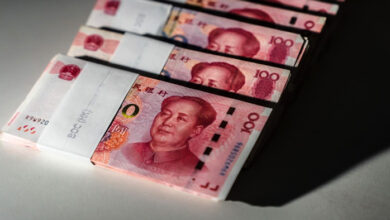Take Five: Rising prices, a chance of a recession, and falling markets

(Reuters) – Central banks are trying to deal with inflation, and falling stock prices are making investors wonder where the “Fed put” went.
The meeting minutes of the world’s top policymakers may give us some clues, and the central banks of New Zealand and South Korea are thinking about how much they need to raise their rates to keep up with the Fed. And as a key deadline approaches, Washington holds the key to a sovereign default by Russia.
Here’s what Ira Iosebashvili in New York, Kevin Buckland in Tokyo, Dhara Ranasinghe, Saikat Chatterjee, and Karin Strohecker in London have to say about the coming week.
1/ WHAT THE FED THINK
Can the Federal Reserve stop the worst inflation in the United States in decades without causing a recession? The minutes from the bank’s meeting on May 25 will give hints.
Chair Jerome Powell is sure that the Fed can achieve a “soft landing,” but these words don’t help the stock markets much as more and more big Wall Street banks warn of a recession. Since March, the Fed has raised rates by 75 basis points, and another 50 basis points are expected to be added in July.
Powell has said that he will raise interest rates as much as is needed to stop inflation. The minutes will show how persistent policymakers think inflation will be and whether growth is strong enough to handle much tighter monetary policy.
(Graphic: https://fingfx.thomsonreuters.com/gfx/mkt/egpbkwygzvq/Pasted%20image%201652922084575.png)
2/ A BEAR HUG
Wall Street is turning to ice. Major stock market indexes are in a bear market. The S&P 500 is down about 19%, and the high-flying Nasdaq has lost more than a quarter of its value since its peak in November 2021. And there’s no end in sight: Barclays (LON:BARC) and Goldman predict more bad news for stocks as rising inflation hurts corporate margins.
Many people are selling. Since the peak of the bond bull market in March 2020, a 30-year U.S. Treasury bond with a constant maturity has lost half of its value, and safe-haven gold is down 6% this quarter. Even the most experienced stock pickers are afraid to make big bets when volatility is going up.
Both small and large investors are pessimistic. The U.S. retail investment sentiment index is close to its lowest point in March 2009, and fund managers have the most cash on hand since September 2011.
(Image: https://fingfx.thomsonreuters.com/gfx/mkt/znvneozkkpl/AAII.JPG)
3/ PIVOT POINT
It’s important to pay attention to Purchasing Managers’ Index (PMI) data from the US, Australia, Britain, Japan, and the euro area that looks ahead. And even more so than usual because central banks are stuck between rising inflation and how it affects consumers, while growth prospects are getting worse because of China’s COVID-related lockdowns and the war in Ukraine.
China quickly got out of its first downturn after the 2020 pandemic, which was caused by a rise in exports and factory production. However, the current downturn could be harder to get out of.
In the coming months, policymakers may reach a point where they can no longer fight inflation and have no choice but to focus on the risk of a recession. PMIs have been stable lately, but they could show how close that turning point is.
(Graphic: http://fingfx.thomsonreuters.com/gfx/mkt/xmpjoxlkovr/PMIS1905.PNG)
4/ EARLY MOVERS CATCHING UP
The central banks of New Zealand and Korea were the first to raise rates, but now the Fed is right on their heels with some big-step hikes.
Most people think that the Reserve Bank of New Zealand will raise rates by another half point on Wednesday to slow down inflation. However, the economy is facing more risks, and recent homebuyers are already feeling the pain of higher mortgage rates.
The new head of Korea’s central bank upset the markets when he said that rates would go up by a half point before his first meeting on Thursday. If a country falls behind, the weak won could be hurt, which would raise the prices of imported food and energy.
Bank Indonesia is one of the few countries that hasn’t moved yet. When they meet on Tuesday, they are likely to decide to stay put for a little longer.
(Graphic: https://fingfx.thomsonreuters.com/gfx/mkt/znpneozzlvl/Pasted%20image%201652964894923.png)
5/ RUSSIA FACES DEFAULT, AGAIN
A U.S. license that lets Moscow make payments is set to expire on May 25, and $100 million in interest payments are due a couple of days after that. This brings back the possibility that Russia will default on its debt.
After Russia’s invasion of Ukraine on Feb. 24, which led to wide-ranging sanctions and countermeasures from Moscow, Russia’s $40 billion of sovereign bonds are just one of the places where things could go wrong.
Also, it’s important to know if gas will keep going to Europe since companies are still trying to figure out how they can buy gas legally if they have to pay in roubles and have to do so by May 20. The EU has told businesses not to open rouble accounts, but it hasn’t gone as far as to say that doing so would be against its sanctions against Moscow. About 40% of the gas in the EU comes from Russia.
(Graphic: https://fingfx.thomsonreuters.com/gfx/mkt/gdpzyewzyvw/Russia percent 20gas percent 20exports.PNG)





